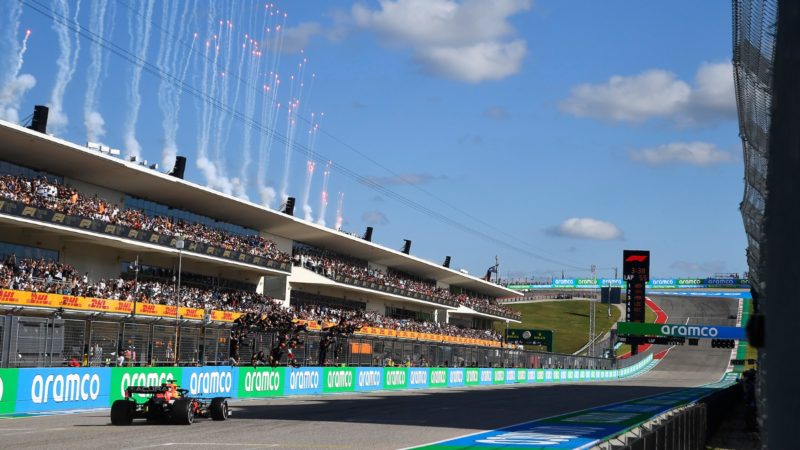Naturally, the complex logistics of moving personnel and equipment around the world mean that some of the requirements aren’t obvious. For example, teams order five sets of permanent equipment, such as tools and furniture, which is packed into containers and shipped to different locations to save on costs and air miles. The calendar is co-ordinated to enable this, allowing, for example, a set of containers to sail to Melbourne and then on to Japan, in plenty of time for each race.
There’s also seasonal weather to contend with, as well as contractual obligations: Abu Dhabi pays a premium to ensure it’s the final race on the calendar while Bahrain has a similar agreement to remain the first. And there are new races to squeeze in too, with the Las Vegas Grand Prix joining the schedule this year.
Formula 1 has recently revealed its planned calendar for the 2024 season — set to start in late February with a record-breaking 24 grands prix. Utilising a more eco-friendly approach, the schedule aims to cut travel by regionalising race weekends while making fan-entertainment a key priority.
It’s a step in the right direction, saving over 6000 miles of travel compared to 2023, while adding in more races, but 2024 still sees plenty of long-haul flights from one grand prix to the next — so we’ve had a go at drawing up a schedule of our own that reduces travel by over 18,000 miles.
The first step was to divide races into six groups, based on their geographical proximity and any seasonal or contractual requirements, as well as maximising the ability to ship equipment rather than fly it.
Given the different locations of teams, we have calculated the mileage from race to race, rather than attempting to factor in return journeys to the factory. So while actual mileages will differ, the figures offer a good indication of travel requirements.
Full proposed F1 calendar:
The calendar features all 24 races with seven back-to-backs.
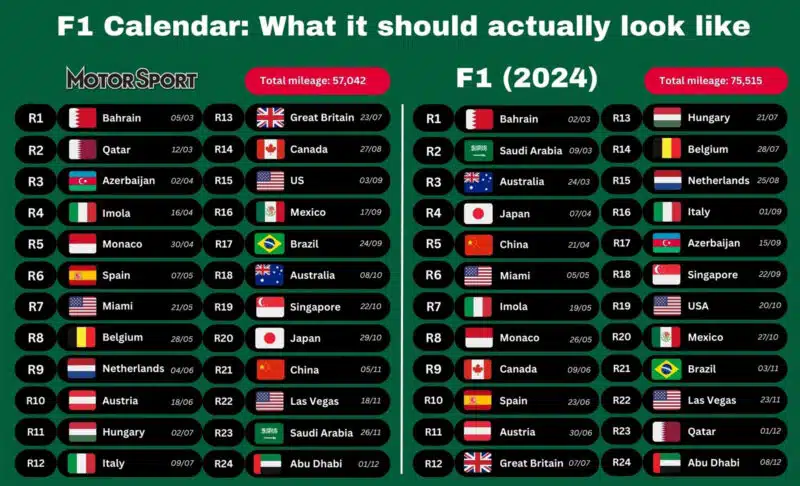
Reducing travelling distance by over 18,000 miles – is this what the 2024 F1 calendar should actually look like?
Stint 1: Bahrain and Qatar
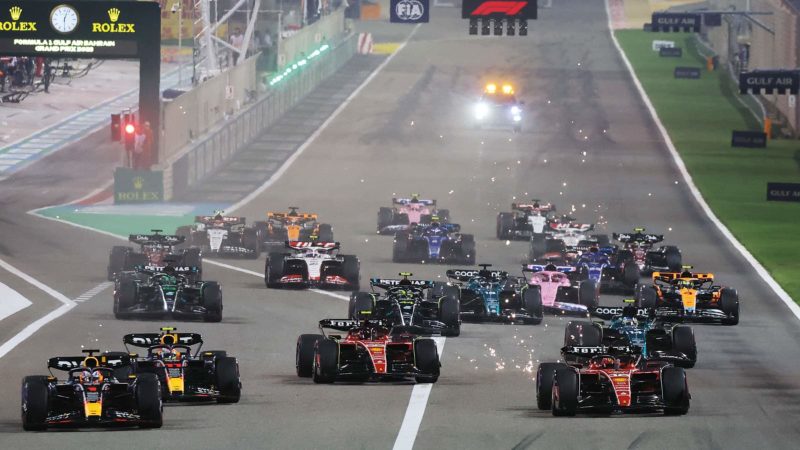
Max Verstappen, far left, leads at the 2023 Bahrain Grand Prix.
Grand Prix Photo
Having hosted pre-season testing and boasting a lengthy F1 contract, the Bahrain Grand Prix remains as the first race of the season. No travel for the teams as well familiarity for the drivers, means it can deliver an entertaining grand prix that sets the season off on a good note.
Next, F1 usually makes the 700 mile journey across the desert to Jeddah for the Saudi Arabian Grand Prix. We think a 88 mile trip to Qatar is a much more logical choice. With circuit properties very similar to Bahrain, teams and drivers could be able to make subtle tweaks that could keep the racing entertaining and offer a smoother transition into F1 for rookie drivers – as apposed to throwing everyone in the deep end on an unforgiving street circuit.
The close proximity of the circuits means F1 could also offer a back-to-back race weekend, allowing for a bigger travel window for the next stint of races whilst giving fans plenty of entertainment to start the season.
Stint 2: Azerbaijan, Imola, Monaco, Spain and Miami

A downpour at Monaco and a disaster for Ferrari in 2022
Getty Images
Our proposed next stop on the F1 calendar swaps a 7400 mile journey to Albert Park for a 1000 mile trip to Baku – a convenient stepping stone for teams before beginning a short tour of Europe. Street circuits divided by challenging race tracks will keep the entertainment value high whilst offering drivers a new challenge every week. Moving around Europe in a circle, jumping to the next closest circuit each time, and with a back-t0-back race in Spain and Monaco teams will be given ample time to travel and prepare.
The second stint of the season ends with a quick trip to the US for the Miami Grand Prix. Although it does involve a 4000 mile flight across the Atlantic, this event needs to included early in the racing year due to Florida’s hurricane season, which is active from June to early November.
Stint 3: Belgium, Netherlands, Austria, Hungary, Italy and Great Britain
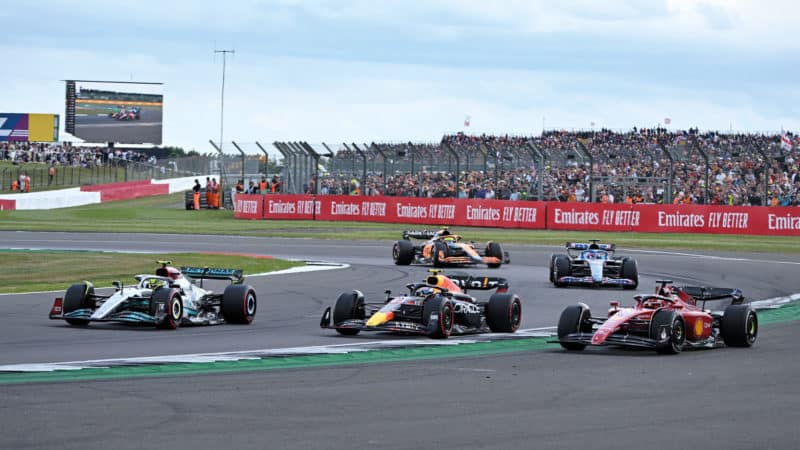
Three wide at Silverstone in 2022
Justin Tallis/AFP via Getty Images
F1 would return to Europe in June, supplying endless action whilst again keeping travel to a minimum between each circuit. Due to it’s heritage and history of producing some of the best racing of the season, the British Grand Prix at Silverstone would perhaps be the perfect way to end the first half of the season, followed by the summer break.
With every F1 team having at least one headquarters in Europe – six based in the UK alone – finishing close to home would keep travel and shipping costs to a minimum for the majority of the grid.
Stint 4: Canada, US, Mexico and Brazil
Leclerc’s inch-perfect pass on Perez during 2022 US Grand Prix
The second half of the 2023 campaign would kick off again in Montreal for the Canadian Grand Prix – the gateway to racing in North and South America. Travelling from north to south, teams could utilise the same travel methods they use in Europe, keeping shipping costs to a minimum whilst striking a good balance between fans across the continents.
Stint 5: Australia, Singapore, Japan, China and Vegas

F1 visits the Las Vegas strip for the first time in 2023
F1
Perhaps the biggest change on our F1 calendar switch up is the choice to move the Australian Grand Prix into the latter part of the year. Since it’s arguably the most remote destination for F1 teams to travel to, it makes more economical sense to include it in F1’s trip to Asia.
Teams would be given two weeks to travel to Melbourne from Brazil, followed by a two week break before back-to-back races in Singapore and Japan and China.
Due to the sheer number of races that have been included on the calendar, it is almost impossible to avoid a triple header at this point in the season, forcing us to include a highly anticipated trip to Las Vegas to finish off a gruelling stint of travel.
Vegas’s F1 contract will keep it on the calendar until 2025, and promoters will be keen to have the race included during the final leg of the F1 season.
Stint 6: Saudi Arabia and Abu Dhabi
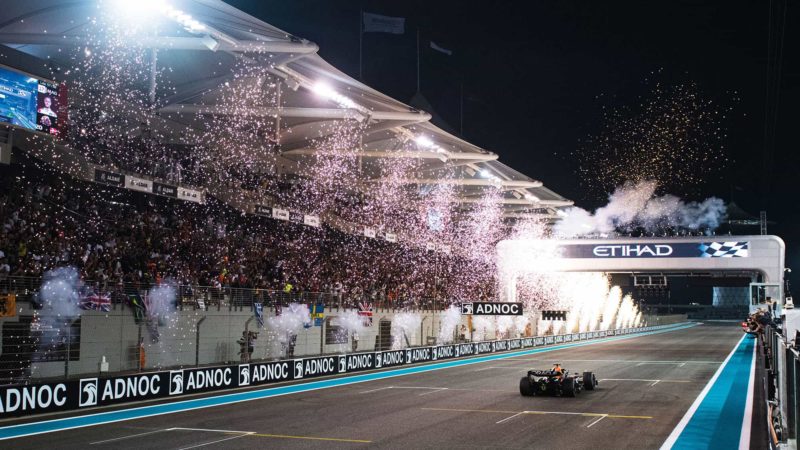
Max Verstappen’s win at the 2022 Abu Dhabi Grand Prix stretched his record for most wins in a season to 15
Getty Images
The last two races of the season sees F1 go full circle, with both Saudi Arabia and Abu Dhabi bordering Bahrain – where the world championship’s journey around the globe began.
In order to keep entertainment value high, F1 insists on finishing the season with back-to-back race weekends, so it’s important that the distance between these races are as short as possible. Currently, teams will be forced to fly over 8200 miles from Las Vegas to Abu Dhabi, but this tole can be dramatically reduced with a 950 mile drive from Jeddah instead.
Hosting its debut race in 2021, Saudi Arabia has already proven its ability to host an exciting penultimate race and will reduce the travel load on the teams and drivers.
Abu Dhabi‘s F1 contract will keep it as the season finale until 2030, therefore keeping its place on the calendar secure.
How do F1 teams transport their equipment?
The space and time between races creates somewhat of a logistical nightmare, having to move tonnes of equipment to and from race venues in a very small time frame, but F1 teams have come up with ways to cope.
The calendar is separated into European and fly-away races – the former utilising transport trucks and the latter using five shipping container kits.
For European races, teams aim to arrive at the circuit a week in advance and will typically have three transport trucks each that contain everything needed for an F1 race weekend. Transportation crews then unload the trucks over five days, aiming to have the paddock completed by Wednesday.
The efficiency of the system means larger teams such as Red Bull and Ferrari will even bring buildings with them due to the reduced shipping costs, which they can then use for hospitality or office spaces.
